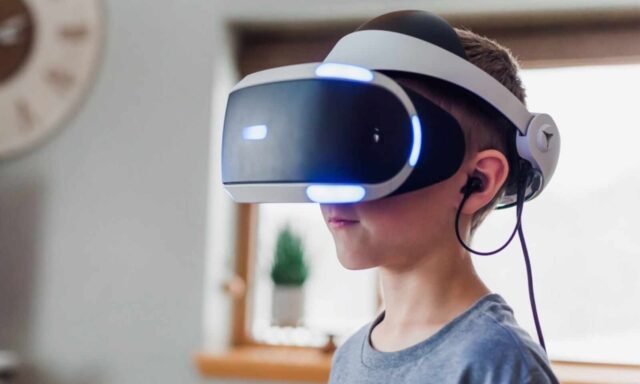Tips for Parents to Help Reverse Amblyopia in Children


Amblyopia, often known as “lazy eye”, is a common visual disorder in children that causes poor vision in one or both eyes. While traditional treatments like patching have been used for decades, the introduction of virtual reality (VR) technology is proving to be a fresh and effective method to treat this disorder.
Consider the case of Emma (name changed for privacy), an eight-year-old diagnosed with Amblyopia at an early age. Her parents were sceptical about the conventional patching technique, as Emma often resisted and became frustrated. However, her interest and enthusiasm for VR-based gaming therapy surged. Over a few months, her visual acuity improved significantly, and she is now on her way to overcoming Amblyopia.
Understanding Amblyopia
Amblyopia, commonly referred to as “lazy eye”, affects 1–4% of the general population and is a leading cause of preventable visual impairment in children. In Amblyopia, the brain misprocesses visual data from one eye, compromising the visual acuity of that eye.
The disorder usually begins in early life and is often due to visual obstruction in one eye, refractive problems, or strabismus (eye misalignment). Early symptoms can be subtle, making diagnosis and treatment often delayed. Signs to watch for include impaired depth perception, hazy or dull vision, and difficulty with tasks requiring solid spatial awareness. Parents should be alert for behaviours like shutting one eye, watery eyes, and poor school performance.
Amblyopia can range from mild to severe and comes in various forms:
- Strabismic Amblyopia: Caused by ocular misalignment.
- Anisometropic Amblyopia: Due to unequal refractive error.
- Deprivation Amblyopia: Resulting from visual blockage in one eye.
- Refractive Amblyopia: Caused by differences in the focusing power of both eyes.
Early detection and appropriate therapy are crucial to prevent irreversible vision loss and improve outcomes for children with this disorder.
Current Treatments for Amblyopia
Traditional Amblyopia therapy has mainly focused on monocular techniques, such as patching the stronger eye to force the use of the weaker eye. However, patching has several drawbacks, including poor compliance, social stigma, and limited effectiveness in restoring normal binocular vision and depth perception.
In contrast, innovative solutions like VR therapy offer a promising alternative. VR-based therapies present different images to each eye, encouraging the brain to cooperate and overcome the suppression of the weaker eye. Studies have shown significant improvements in visual acuity and stereopsis with this approach.
VR therapies engage the patient, enhance binocular function, and provide a more pleasant and participatory experience than conventional patching, thereby increasing their success rate. Here is a comparison of the two approaches:
By leveraging the potential of emerging technology, VR-based therapies offer a more comprehensive and effective way to treat Amblyopia in children.
Tips for Parents
Precautions
Regular eye check-ups are essential for early detection and treatment of Amblyopia. Parents should be vigilant about their children’s behaviour, as specific symptoms might indicate the presence of Amblyopia. Symptoms include watery eyes, shutting or squinting one eye, and taking longer to complete school assignments. If any of these signs are observed, it is crucial to consult an eye care specialist for a thorough evaluation.
Treatment
- Eye Care
- Patching is a commonly used treatment for Amblyopia, involving covering the stronger eye to encourage the weaker eye to work harder and improve its visual acuity. Parents should ensure the child wears the patch consistently and follows the prescribed patching schedule.
- VR-based treatments for Amblyopia are becoming increasingly popular due to their effectiveness and engaging nature. These treatments involve the use of standalone VR games specifically designed to stimulate the weaker eye and improve visual acuity. Unlike traditional patching, VR therapy engages both eyes, promoting proper visual processing and cooperation between them.
- Parents should ensure that their child regularly uses the prescribed VR games as part of their treatment plan. These games provide an immersive experience that not only helps in improving the weaker eye but also makes the therapy enjoyable for the child.
- Consistency with Treatment
- Treating Amblyopia with VR-based methods requires consistency and patience. Parents should develop and adhere to a treatment plan in collaboration with their child’s eye care practitioner. This plan may include regular follow-up visits, therapy adjustments, and continuous support to monitor the child’s progress and make necessary changes to the treatment regimen.
- Strengthening Exercises
- Standalone VR games designed for Amblyopia treatment offer a range of exercises that strengthen the weaker eye and enhance binocular vision. These games are specifically developed to engage both eyes and encourage the brain to process visual information correctly.
- Parents should incorporate these VR exercises into their child’s daily routine. Working closely with their eye care provider, they can monitor progress and ensure the therapy is effective. The engaging and interactive nature of VR games increases the likelihood of adherence to the treatment plan, making the therapy both effective and enjoyable.
Conclusion
Consistent treatment of Amblyopia can help reverse the condition, and VR-based gaming therapy is an exciting and effective method. Globally, studies and data consistently show how well VR therapies improve visual acuity and stereopsis. For example, research in the United States has demonstrated significant improvements in visual performance with VR treatment for children with Amblyopia.
As we move forward, it is essential to understand the importance of treating Amblyopia in children. Early detection and consistent care are crucial to prevent long-term vision loss and ensure children receive the necessary therapy. Addressing these challenges helps us better support children with Amblyopia and improve their visual health outcomes.
 By Ishaan Singh, Co-Founder & Head Strategic Alliances, Cognihab.
By Ishaan Singh, Co-Founder & Head Strategic Alliances, Cognihab.
Ishaan Singh is the Co-Founder and Head of Strategic Alliances at Cognihab, on the mission to create the world’s most advanced virtual reality/digital healthcare solution provider. He has created and delivered innovative VR solutions to help patients suffering from various conditions, such as vision disorder, stroke, spinal cord injury, autism, cerebral palsy, cancer, depression, and anxiety.
Source link




